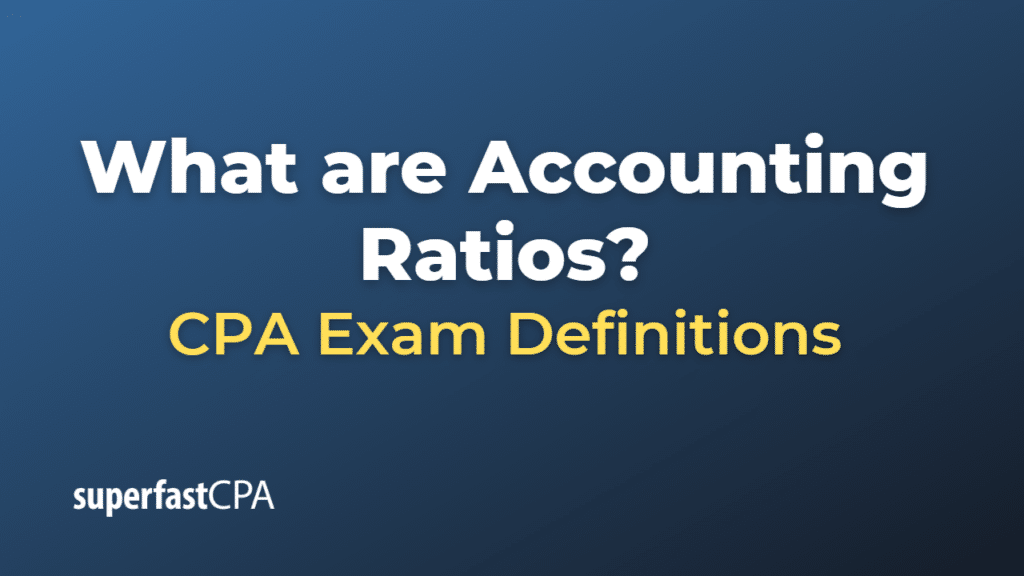Accounting Ratios
Accounting ratios, also known as financial ratios, are numerical values derived from a company’s financial statements, such as the balance sheet, income statement, and cash flow statement. These ratios are used to evaluate a company’s financial performance, financial position, efficiency, liquidity, and profitability. Accounting ratios are valuable tools for investors, creditors, analysts, and management to make informed decisions and comparisons between companies, industries, and historical periods.
There are several categories of accounting ratios, including:
- Liquidity Ratios: These ratios measure a company’s ability to meet its short-term financial obligations. Common liquidity ratios include the current ratio, quick ratio (or acid-test ratio), and cash ratio.
- Solvency Ratios: These ratios assess a company’s ability to meet its long-term financial obligations and the overall financial health of the company. Examples of solvency ratios are the debt-to-equity ratio, debt ratio, and equity ratio.
- Profitability Ratios: These ratios evaluate a company’s ability to generate profits in relation to its revenues, assets, and equity. Common profitability ratios include the gross profit margin, net profit margin, return on assets (ROA), and return on equity (ROE).
- Efficiency Ratios: These ratios measure how effectively a company utilizes its assets and resources to generate sales and profits. Examples of efficiency ratios are inventory turnover, accounts receivable turnover, accounts payable turnover, and asset turnover.
- Market Ratios: These ratios are used to evaluate the market value of a company’s shares relative to its earnings, cash flow, or book value. Common market ratios include the price-to-earnings (P/E) ratio, price-to-sales ratio, price-to-cash-flow ratio, and price-to-book ratio.
By analyzing accounting ratios, stakeholders can gain valuable insights into a company’s financial performance and position, identify trends and potential issues, and make informed decisions about investing in, lending to, or managing a company.
Example of Accounting Ratios
Let’s consider a hypothetical example of a company, “TechCo,” to illustrate the calculation and interpretation of a few common accounting ratios.
TechCo has the following financial data:
- Current Assets: $500,000
- Current Liabilities: $300,000
- Total Assets: $1,000,000
- Total Liabilities: $600,000
- Total Equity: $400,000
- Net Sales: $1,500,000
- Cost of Goods Sold (COGS): $900,000
- Net Income: $200,000
We’ll calculate and interpret three common accounting ratios: current ratio (liquidity ratio), debt-to-equity ratio (solvency ratio), and net profit margin (profitability ratio).
- Current Ratio: Current Ratio = Current Assets / Current Liabilities
Current Ratio = $500,000 / $300,000 = 1.67
The current ratio of 1.67 indicates that TechCo has $1.67 in current assets for every $1 in current liabilities, which suggests that the company is in a good position to meet its short-term financial obligations.
- Debt-to-Equity Ratio: Debt-to-Equity Ratio = Total Liabilities / Total Equity
Debt-to-Equity Ratio = $600,000 / $400,000 = 1.5
A debt-to-equity ratio of 1.5 indicates that TechCo has $1.50 in liabilities for every $1 in equity. This ratio can be used to assess the company’s financial leverage and risk. A higher ratio may indicate a higher risk for investors, as it means the company relies more on debt financing.
- Net Profit Margin: Net Profit Margin = (Net Income / Net Sales) x 100
Net Profit Margin = ($200,000 / $1,500,000) x 100 = 13.33%
A net profit margin of 13.33% indicates that TechCo generates $0.1333 in net income for every $1 of sales revenue. This ratio can be used to assess the company’s profitability and how effectively it converts sales into profits.
These three accounting ratios provide a glimpse into TechCo’s financial health, covering its liquidity, solvency, and profitability. It’s essential to consider a comprehensive set of accounting ratios and compare them with industry benchmarks or competitors to gain a more accurate understanding of a company’s overall financial performance and position.













